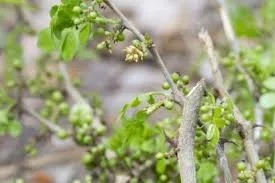NAME: Fagara rubescens
FAMILY: Rutaceae (Rue family)
COMMON NAMES: prickly ash
LOCAL NAMES: N/A
MORPHOLOGICAL DESCRIPTION: Fagara rubescens is a shrub or small tree that belongs to the Rutaceae family. It has a dense and bushy growth habit, with multiple stems branching out from the base. The leaves are compound and alternate, composed of several leaflets that are glossy green in color. The leaflets have a lanceolate or elliptical shape and may exhibit serrated margins. The plant produces small, inconspicuous flowers that are typically greenish-white or yellowish. The fruits of Fagara rubescens are small, rounded berries that turn reddish or purplish when ripe.
USEFUL PART(s): Various parts of Fagara rubescens, including the bark, leaves, and roots, may have traditional medicinal uses in certain regions.
GENERAL USES: Fagara rubescens has a long history of traditional medicinal use in different parts of the world. The bark, leaves, and roots of the plant are often used to prepare herbal remedies for a variety of health conditions. The specific traditional uses may vary, but they can include the treatment of digestive disorders, respiratory ailments, skin conditions, and fevers. It is important to note that further scientific research is needed to validate the medicinal properties and uses of Fagara rubescens.
GEOGRAPHIC DISTRIBUTION: Fagara rubescens is native to various regions in Africa, including countries such as Cameroon, Nigeria, Angola, and Tanzania. It is typically found in forested areas, woodlands, and savannas.
WHY IS IT GREEN? Like all plants, Fagara rubescens appears green due to the presence of chlorophyll. Chlorophyll is a pigment that captures light energy from the sun and converts it into chemical energy through photosynthesis. The green color is a result of chlorophyll molecules absorbing light in the blue and red parts of the spectrum and reflecting green light.
ENVIRONMENTAL IMPACT: The environmental impact of Fagara rubescens is not extensively documented. As a native plant in certain regions, it likely plays a role in local ecosystems by providing habitat and potentially serving as a food source for certain animals. However, specific information on its ecological interactions and environmental impacts is limited.
FUN FACT: Fagara rubescens is known for its aromatic properties. When the leaves or bark of the plant are crushed or bruised, they release a distinct fragrance that is often described as spicy or citrus-like. This aroma contributes to its appeal and may have cultural significance in certain regions.
Further Reading:
"Medicinal Plants of East Africa" by John Kokwaro
"Ethnobotany and Medicinal Plants of Kenya" by N. G. Jansen van Rensburg and R. H. T. Kruger


